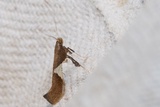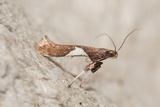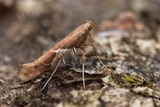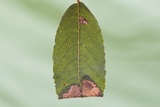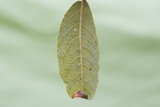Caloptilia stigmatella (Fabricius, 1781) Species
Last modified: Dec. 10, 2025, 1:59 p.m.
A common species throughout Belgium.
Details
- Classification
- Family: Gracillariidae > Subfamily: Gracillariinae > Tribus: Gracillariini > Genus: Caloptilia > Species: Caloptilia stigmatella
- Vernacular names
- Wilgensteltmot (NL), Weiden-Blatttütenmotte (DE)
- Synonyms
- Caloptilia upupaepennella (Hübner, 1796)
- First mention in Belgium
- De Sélys-Longchamps E. 1844. Énumération des insectes Lépidoptères de la Belgique. — Mémoires de la Société royale des Sciences de Liége 2: 1–35. On page 25 (as upupaepennella). view page
- Status
-
Native
Distribution
Caterpillar
The caterpillar is light green with a light brown head capsule.
Mine
At first a rather long serpentine mine at the underside of the leaf, most of the time parallel with the main vein, but later on turning to the leaf margin where it is widened into a small whitish blotch. The caterpillar in this blotch starts eating the parenchyma and spins the mine into a tentiform shape which after a while turns brownish. Later instars leave the mine and spin a tip of the leaf downwards. The last instar spins the leaf downwards into a leaf roll.
See also gracillariidae.net and bladmineerders.be.
Cocoon/pupa
A semi-transparent cocoon at the underside of a leaf.
Bionomics
Mines can be found from May till early October. The pupal skin protrudes from the cocoon, after the emergence of the adult.
The adults hibernate and can be observed feeding on the catkins of Salix trees in early spring.
Flight periods
There is usually only one long generation per year of which the moths can be found from September, hibernating, till May of the next year. However, fresh specimens have been found from May onwards to August, supposing the occurrence of a partly second generation.
Observed on
- Host plant (species):
- Salix alba, Salix aurita, Salix babylonica, Salix cinerea, Salix fragilis, Salix pentandra, Salix purpurea, Salix repens, Salix triandra, Salix viminalis, Populus alba, Populus nigra, Populus tremula, Populus × canadensis and Myrica gale
- Host plant (genera):
- Populus and Salix
The larvae feed oligophagous on several species of Populus and Salix, rarely also on Myrica gale.
